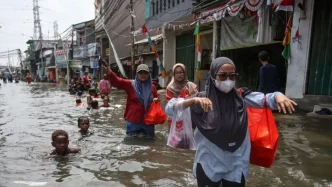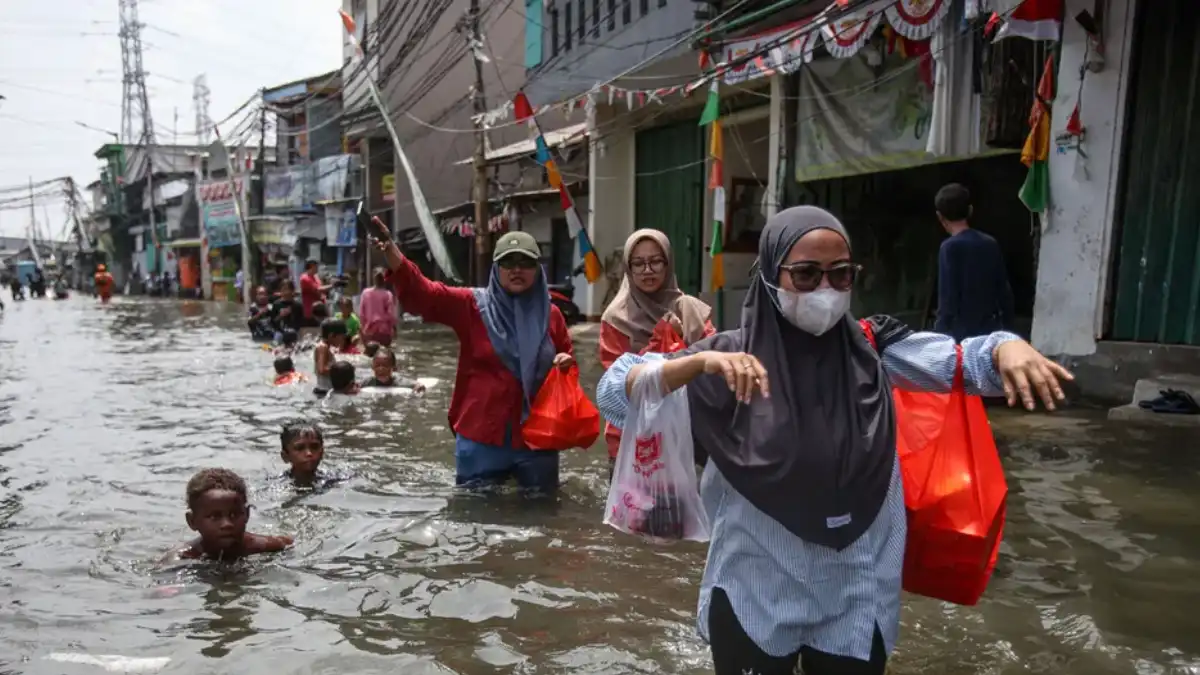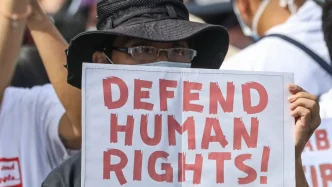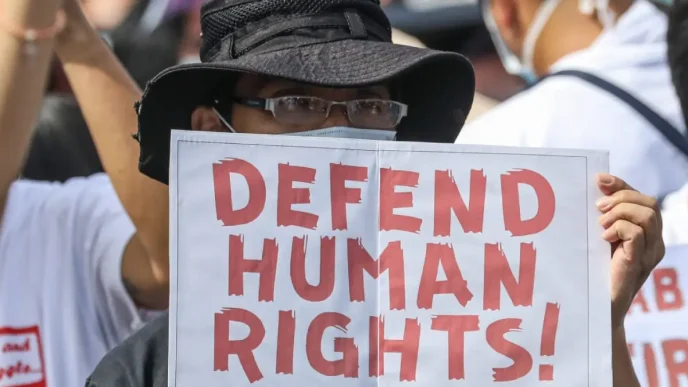Jakarta’s northern coastal areas are grappling with severe tidal flooding, with water levels reaching up to one meter in some regions, as officials warn that the inundation could persist until the end of June 2025. The flooding, attributed to a rare celestial alignment, has disrupted daily life for hundreds of households and sparked renewed debate over long-term solutions to protect Indonesia’s capital from recurring environmental challenges.
High Tides and Celestial Causes
The Meteorology, Climatology and Geophysics Agency (BMKG) has identified the flooding as a consequence of a super new moon, a phenomenon where the Moon passes between the Sun and Earth at its closest orbital point, known as perigee. “The perigee phase on June 23, 2025, combined with the new moon on June 25, 2025, is likely to increase the maximum sea level” said Eko Prasetyo, BMKG’s maritime meteorology director, in a statement reported by Kompas.com. The agency forecasts that high tide flooding will affect northern coastal regions, including Ancol, Cilincing, Kamal Muara, Kapuk Muara, Muara Angke, and Tanjung Priok, between June 24 and 29.
Residents in these areas have been urged to remain vigilant. “Community activities around ports and coastal areas will be affected, and residents are urged to remain alert and prepare for the potential impacts of the high tide” Eko added. The warning comes as roughly 600 households in Muara Angke, a fishing community, found their homes submerged under 50 to 90 centimeters of water on June 24. Other areas, such as the vicinity of Jakarta International Stadium (JIS) in Tanjung Priok, have also been impacted, with tidal waters flooding a nearby railway line, though train services remain operational.
Community Impact and Immediate Response
For many in North Jakarta, the flooding has become a distressing routine. Homes have been inundated, forcing residents to clean and salvage belongings amidst rising waters. The Jakarta Disaster Mitigation Agency (BPBD) is actively monitoring the situation, with Mohamad Yohan, head of the agency’s data and information center, affirming their commitment to support affected communities. “We are coordinating with local community leaders and district heads to prepare basic necessities for residents impacted by the flooding” Yohan told state news agency Antara on June 25.
The Social Affairs Ministry has stepped in with aid, distributing approximately Rp 202 million (US$12,400) worth of supplies, including 400 packages of ready-to-eat meals, 300 mattresses, and 400 blankets. Marsyani Mansyur, the ministry’s director of social protection for disaster victims, emphasized a collaborative approach. “We are also working closely with the North Jakarta Social Agency to conduct assessments and gather data on the needs of affected residents” she noted. This immediate relief offers a lifeline to families struggling with the sudden disruption, though many wonder how long such measures can sustain them against recurring floods.
Underlying Challenges: Land Subsidence and Climate Risks
Jakarta’s vulnerability to tidal flooding is not solely a product of celestial events. The city, home to over 10 million people, is sinking at an alarming rate due to land subsidence, exacerbated by excessive groundwater extraction and rapid urbanization. Some areas of North Jakarta are subsiding by as much as 25 centimeters per year, according to studies by the Bandung Institute of Technology. This sinking, combined with rising sea levels driven by climate change, creates a perfect storm for coastal inundation, particularly during high tide events like the one currently unfolding.
The BMKG has linked the increasing frequency of such floods to broader environmental shifts, noting that delayed dry seasons and erratic weather patterns are compounding the city’s challenges. Just earlier this year, floods and landslides struck various regions of Indonesia, a reminder of the archipelago’s exposure to natural disasters. For Jakarta, the stakes are particularly high: as the political and economic heart of the nation, disruptions here reverberate across the country, affecting trade, infrastructure, and public confidence in governance.
Short-Term Fixes and Long-Term Plans
In response to the current crisis, the Jakarta administration is taking steps to mitigate impacts. Additional water pumps are slated for installation in coastal areas to manage floodwaters, while a 1.4-kilometer-long embankment in Muara Angke is under construction, with completion expected by December 2025. These measures aim to provide immediate relief, though their effectiveness against the scale of tidal flooding remains to be seen.
On a larger scale, the administration has endorsed President Prabowo Subianto’s ambitious proposal for a Giant Sea Wall along the northern coast of Java. The megaproject, intended to combat both tidal flooding and land subsidence, could reshape Jakarta’s relationship with the sea. Proponents argue that it is a necessary investment for the city’s survival, pointing to successful precedents like the Netherlands’ Delta Works. The wall, if realized, would span dozens of kilometers, incorporating infrastructure for water management and urban development.
Yet, the plan is not without controversy. Critics have raised concerns over its financial feasibility, with cost estimates running into the tens of billions of dollars. Environmentalists warn of potential ecological damage to marine ecosystems and coastal livelihoods, while political analysts caution that the project could become a lightning rod for public discontent if mismanaged. The debate underscores a broader tension in Indonesia’s approach to infrastructure: balancing urgent needs with sustainable, equitable outcomes.
Public Sentiment and Political Implications
As floodwaters linger, public frustration is palpable in North Jakarta’s hardest-hit communities. Fishermen in Muara Angke, whose livelihoods depend on access to the sea, find themselves doubly burdened by disrupted work and damaged homes. Social media platforms like X have amplified these voices, with many residents questioning why recurring floods continue to catch authorities off guard. Posts tagged with Jakarta flooding hashtags reveal a mix of resignation and calls for accountability, reflecting a city weary of temporary fixes.
For President Prabowo Subianto, who assumed office in late 2024, the flooding crisis presents an early test of his administration’s ability to deliver on infrastructure promises. His support for the Giant Sea Wall ties directly to his broader vision of national resilience, but turning rhetoric into results will require navigating complex political and fiscal landscapes. Opposition figures have already seized on the flooding to critique government preparedness, framing it as a failure to prioritize vulnerable communities over grandiose projects.
A City at a Crossroads
Jakarta’s battle with tidal flooding is emblematic of the challenges facing many coastal megacities in the Global South. With climate change accelerating sea level rise and urban populations swelling, the city stands at a crossroads between adaptation and crisis. The current inundation, while tied to a specific lunar event, serves as a stark reminder of systemic issues—land subsidence, inadequate infrastructure, and environmental degradation—that cannot be ignored.
The immediate focus remains on supporting affected residents and minimizing disruption through pumps and aid. But as the waters recede, larger questions loom: Can Jakarta build a future resilient to the tides, and at what cost? The Giant Sea Wall, for all its controversy, represents one possible path forward, though its success hinges on transparent planning and public trust. For now, the city watches and waits, hoping that June’s high tides mark not just a natural phenomenon, but a turning point in its fight against an encroaching sea.
As Jakarta braces for more days of flooding, the resilience of its people shines through, even as the search for lasting solutions continues to test the limits of policy and patience.
















